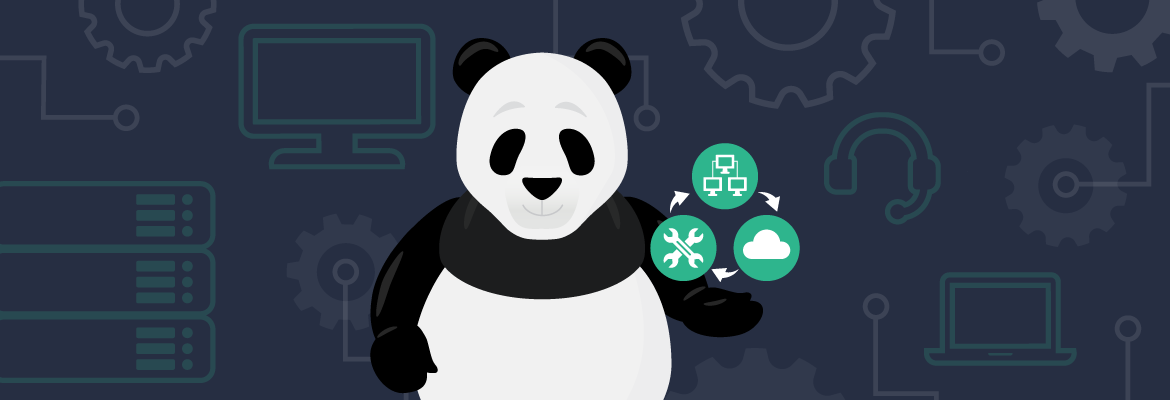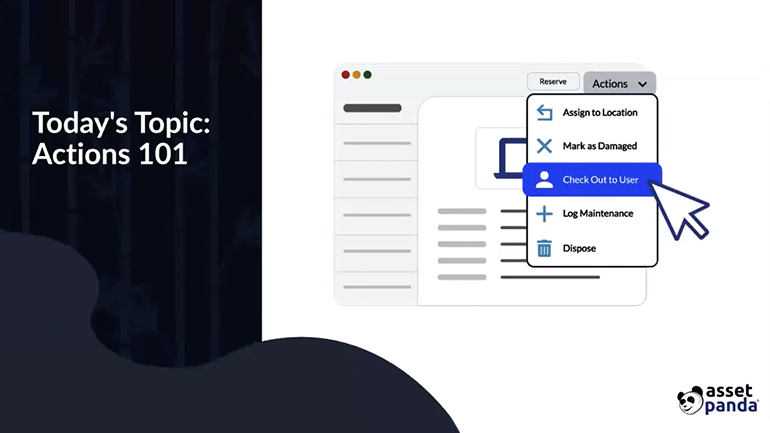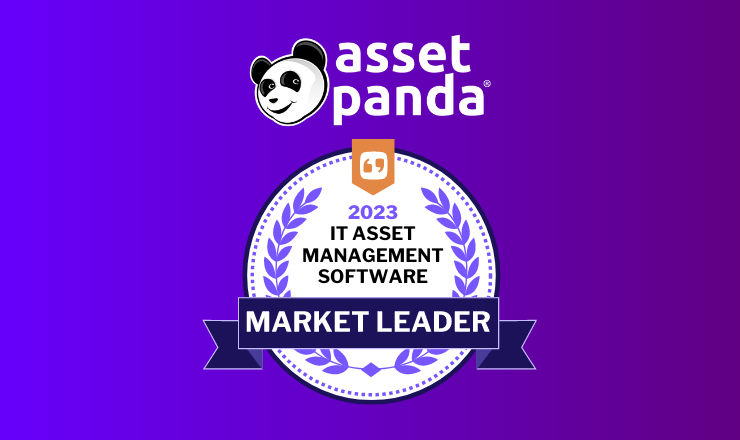IT Asset Management Best Practices

As organizations continue to work in remote and hybrid environments, your IT assets, such as laptops, monitors, and other hardware, no longer stay in one place. To keep these items in working order and avoid potential business disruptions, you need to be able to effectively track and manage your IT assets at any given time. In short, you need to set up practices for IT asset management.
Let’s take a look at what IT asset management is, how it benefits your organization, and best practices for managing IT assets.
What is IT Asset Management?
IT asset management (ITAM) is the practice of managing your organization’s technology assets throughout their lifecycles, from acquisition to disposal. An IT asset can be physical (e.g., servers, desktop computers and laptops, keyboards, monitors, and other hardware) or digital (e.g., software licenses, licensing agreements for public and private clouds, etc.). The purpose of IT asset management is to gain visibility and control over your entire asset estate so you can improve operational efficiency, optimize asset usage, and minimize your total cost of ownership.
To properly manage your IT assets, it’s important to implement a comprehensive ITAM strategy and software that allows you to track the status, location, and utilization of your assets in real-time. When you can accurately audit and report on your IT inventory, you can optimize device deployment, anticipate upcoming warranty expirations, and forecast future purchasing needs. When you effectively manage your IT asset estate, your organization can avoid potential business disruptions and unforeseen costs.
8 Benefits of IT Asset Management
A thorough IT asset management program has various operational and financial benefits for your organization. Let’s look at 8 of the most common benefits and how to achieve them.
- Streamlined asset management: With comprehensive IT asset management software, you’ll have clear processes to upload assets, assign them to employees, send things for repair, and much more. These streamlined asset management workflows will significantly reduce manual effort and decrease the risk of errors or siloed information.
- Improved operational efficiency: By streamlining your asset management processes, your team will also save lots of time and resources managing IT assets. Rather than manually tracking items in spreadsheets – or not tracking them at all – your team can quickly deploy devices with as little as a barcode scan. This allows you to improve overall operational efficiency and give everyone time back to work on other projects that are important to the business.
- Visibility into the entire lifecycle of your assets: With all your asset estate data in one centralized platform, you’ll be able to access the full lifecycle history of your IT devices. Now, you can see who a device has been assigned to over its life, how many times it’s been repaired, if there’s a remaining warranty on it, and any other relevant data points you’re tracking.
- Optimized device and asset utilization: When you have visibility and control over the full lifecycle of your IT hardware, you can easily optimize its respective utilization. Optimizing asset utilization ensures your devices are being used to their best ability and gives your employees the right tools to perform their jobs effectively.
- Better forecasting and budgeting: By optimizing asset usage and understanding their full lifecycle, you can better plan for future purchasing needs. You’ll not only be able to forecast when devices are due for replacement but provide accurate data to support this need and secure the necessary budget.
- Enhanced accountability: IT asset management allows you to keep tabs on where a device is and who it’s assigned to at any given time. This way, if an item is unexpectedly found damaged, lost, or stolen, you can hold the right person accountable.
- Improved warranty and contract management: With robust individual asset records, you can store warranty and service contract information for every last IT asset. Keeping track of these can help you forecast when an item might need a replacement or a service contract renewal.
- Increased security and compliance: By knowing exactly which assets are (and aren’t) part of your network through auto-discovery, you can identify any rogue devices or other threats to increase security. With accurate, real-time data on your IT asset inventory, you can ensure that you’ll remain compliant with state or federal regulations or funding requirements.
5 Risks You May Face Without IT Asset Management
It’s no secret that your IT assets are a foundational piece of your business. From servers to laptops and everything in between, these devices keep your network and your team up and running. To keep these items in working order, you need to accurately track their status and condition through IT asset management.
IT asset management is the practice of managing your organization’s technology assets throughout their lifecycles, from acquisition to disposal. When done well, IT asset management can help you gain visibility and control over your entire asset estate so you can improve operational efficiency, optimize asset usage, and minimize your total cost of ownership. While there are numerous other benefits to IT asset management, there are also several operational risks at stake when you don’t properly manage these items.
Let’s look at 5 risks you may face without IT asset management.
Lack of visibility into your assets
Without real-time data into your asset estate, you may not have the correct information on a device’s status, condition, or whereabouts. A lack of accurate information could cause you to assign a device to one employee when it’s already checked out to another. And without proper asset control, you’ll be unable to hold someone accountable for damaged, lost, or stolen devices.
Decreased productivity
When you don’t have the right tools to manage an essential part of your workforce – your IT assets – your team can’t work as productively as possible. They may be using old or damaged devices because the full asset lifecycle isn’t being tracked and they can’t easily request repairs in one centralized place. Without the best devices available, your team won’t be able to work as quickly or efficiently, causing you to lose a competitive advantage in the market.
Potential business disruptions
Lack of insight into your IT asset estate not only hurts your team’s productivity but can also lead to business disruptions. Whether a device gets lost or needs an unexpected replacement, that team member won’t be able to perform their job duties for the time being, and you’ll need to make an unforeseen purchase to get them up and running again.
Inability to report on and audit your asset estate
To understand what’s happening with your IT asset estate at any given time, you need to be able to pull real-time reports. When the leadership team or finance department requests IT asset reports or audits, you’ll have to input a lot of last-minute manual work to make that happen without the data readily available.
Inability to forecast future purchasing needs
Without accurate data on the full lifecycle of your IT assets, you’ll also struggle to accurately forecast and budget for future device purchases. This could land you in several unfavorable situations, from having too little to having a surplus of assets, not getting enough budget for the device models your team needs to perform their best, and so on.
What to Consider When Selecting the Right IT Asset Management Platform
To avoid all of the above risks, you need a proper IT asset management solution that provides real-time visibility into the full lifecycle of your assets. Here are factors to consider when selecting the right IT asset management platform for your organization:
- Customizability: Your chosen software should be easily customizable to match your unique naming conventions, use cases, and workflows. You should also ensure an IT asset management platform allows for customizable alerts and notifications so you’re aware of any changes made in real time.
- Ease of use: The right solution should also be user-friendly and easy to navigate so your team can get up to speed quickly.
- Scalability: Whether you have other departments looking to track assets or your business is growing, you want to choose IT asset management software that can scale with you.
- Integrations: To create one centralized place for your asset estate data, you want a platform that integrates into your existing tech stack. Look for solutions that offer integrations with help desks, network management tools, financial management systems, active directories, and device managers.
- Audits and reporting: Your chosen software should provide robust reporting and audit capabilities. Look for a platform with customizable visual dashboards that allow you and your stakeholders to easily analyze asset data.
- Mobile app: To simplify your audits, consider an IT asset management solution with a mobile app and built-in barcode scanning technology. Mobile access will help you streamline your audit process so your team can conduct audits more frequently, ensuring more accurate data.
- Security: A platform’s security features are perhaps the most important factors to consider before signing on. Ask whether the software is cloud-based or on-premise, if it has security certifications like SOC 2, and if it offers features like robust user permissions, single sign-on, and SFTP.
- Implementation and support: In order to use your new software solution effectively, you need proper training and support. Ensure that your IT asset management provider offers robust onboarding and ongoing customer support.
- Customer testimonials: Of course, don’t forget to review various forms of social proof, like case studies and third-party review sites, to get honest feedback from real customers.
Best Practices for Effectively Managing Your IT Assets
With the right software in place, you’re ready to put your IT asset management program into action. Let’s look at some best practices to help you effectively manage your IT assets.
Create a clear ITAM strategy
As with any business plan, you must first build a framework to properly upload and manage your IT assets in your chosen software. Start by creating a list of IT asset management goals personal to your organization. The main objectives of IT asset management are to track your assets and boost your organization’s efficiency, both of which you can’t do without a plan.
Define what you consider an IT asset and want to include in your inventory
As we mentioned at the start of this article, many items can be considered IT assets across your hardware and software. Before you even begin to inventory IT assets to your new platform, it is essential to define what will count as an individual asset versus what might be part of a kit. Kitting smaller items like headphones, keyboards, and mice can help streamline asset deployment processes.
When taking stock of your IT inventory, you can easily see the assets that are on and off your network through auto-discovery. Auto-discovery helps you get real-time data on the devices currently accessing your network so you can easily account for any discrepancies. These discrepancies can show you 1. if any items may have been lost or stolen and 2. the number of off-network devices you have, indicating a surplus and helping you better plan for future IT asset purchases.
Name and tag your IT assets accordingly
Once you’ve decided which items are part of your IT asset estate, you must ensure that each asset has its own unique ID. This will make it easy to upload the assets into your software, so you know what is what. Ideally, you should also tag each asset with its own barcode label so you can more easily deploy and audit them in the future.
If you’re unsure where to start, take a look at some common IT asset tagging best practices.
Use a lifecycle-based approach to ITAM
After your assets each have their own unique IDs and/or barcodes, you’re ready to set clear processes for your IT asset management program. These processes should cover the entire lifecycle of your assets and go beyond simply registering and tracking IT assets. When outlining your strategies, consider each of the following stages:
- Procurement: Budgeting for and purchasing your assets
- Asset identification and registration: Capturing asset details like type, serial number, specifications, purchase date, warranty, etc.
- Deployment: Distributing IT assets to their intended users or departments (this can include asset tagging, assignment, configuration, installation, etc.)
- Asset tracking and monitoring: Routinely reporting on the status of your assets and conducting audits to ensure data remains accurate
- Maintenance and support: Proactively tracking maintenance and repair needs as well as warranty and support service contract expirations
- Asset retirement and disposal (ITAD): Retiring assets at the end of their life and recycling or disposing of them properly
- Refreshing and replacement: Replacing IT assets that have been disposed of or are no longer meeting organization’s needs in terms of cost-effectiveness and technological advancements
Get your entire team on the same page
Once you’ve created your ITAM strategy and processes, it’s time to put your plan into action and begin the implementation phase.
Include all your end-users from the start
Include all your potential end-users in the onboarding process to ensure your entire team is on the same page. They should be well-versed in both the platform’s UI and the processes that you laid out in your ITAM strategy.
Of course, make sure the plan and processes are easily accessible to everyone at all times. Proper onboarding and documentation will help you achieve higher adoption rates and, in turn, run an effective ITAM program.
Assign the right permissions to the right users
While you want your entire team to be up to speed on your new IT asset management processes, not every single person needs to have admin-level access. You might have Power Users who can approve asset reservations and edit report fields, whereas your standard Users may have view-only access to assets and reports. Managing access helps you reduce the chance of human error and increases the security of your program.
Automate your ITAM workflows and reports wherever possible
With your IT asset management program up and running, you’ll quickly see an increase in efficiency and time savings. However, there could be even more opportunities to save time and resources when you automate your ITAM workflows and reports. Some examples of automations can include:
- Setting a status to automatically update when an action is performed (e.g., a laptop’s status changes to “Assigned to Employee” when it is checked out)
- Automatically syncing data to and from integrated applications for real-time data consistency (e.g., asset discovery, helpdesks, device managers, and more)
- Generating automatic reports at a set day and time so you can regularly review your IT asset estate metrics
While these automations clearly streamline workflows and spare your manual effort, they can have various benefits, including:
- Avoid overstocking or understocking your required asset inventory
- Remove ghost assets from accounting records
- Track device depreciation for potential tax rebate
- Ensure regulatory compliance
- Forecast future purchasing needs
Regularly conduct audits of your IT asset estate
While you should ideally keep up with the status of your IT asset estate through automated reports and real-time visual dashboards, it is paramount to know the condition of your assets as well. Whether it be monthly or quarterly, be sure to conduct regularly scheduled audits of your IT assets so you can maintain accurate data. Audits help you track the condition and location of your assets and hold team members accountable if items are lost, damaged, or stolen.
Track device warranties and other support service contracts
When managing your IT assets in one centralized place, you don’t simply want to track an item’s ID number and location. You want to track its entire asset history, including warranty information, repair history, and any associated support service contracts.
This will not only help your end-users see if an item can be repaired through a warranty or third-party service but can also inform management of whether an asset needs a support contract re-upped or will need to be replaced altogether.
Leverage data for decision making and improved asset utilization
By performing IT asset audits and keeping record histories, you can keep tabs on your asset estate and ensure everything is in working order. While this is a wise use of data, it’s important to consider the bigger picture as you gather and analyze more IT asset data over time. For example, it’s essential to look at the entire lifecycle of all your IT assets to:
- Improve asset utilization so devices aren’t out-of-date or underused
- Estimate the typical lifespan of specific IT assets
- Forecast and secure budget for future purchasing needs
All this and more will help you keep your IT assets in working order so you can supply your team with the proper devices to do their best work while minimizing your total cost of ownership.
How to Get Started with IT Asset Management
Building an effective IT asset management program doesn’t happen overnight. But when you take the time to create a thoughtful strategy and invest in the right software for your needs, your team will boost efficiency and, ultimately, save time and money.
To learn even more about building your ITAM program, check out these resources:
If you’re ready to put your ITAM plans into motion, Asset Panda can help. Request your demo today to see our IT asset management platform in action.
Related News & Press

Learn more from an Asset Panda expert
Get a FREE consultation with an asset tracking expert to find out how you can transform your asset tracking.
Contact our Sales Team at (888) 928-6112


